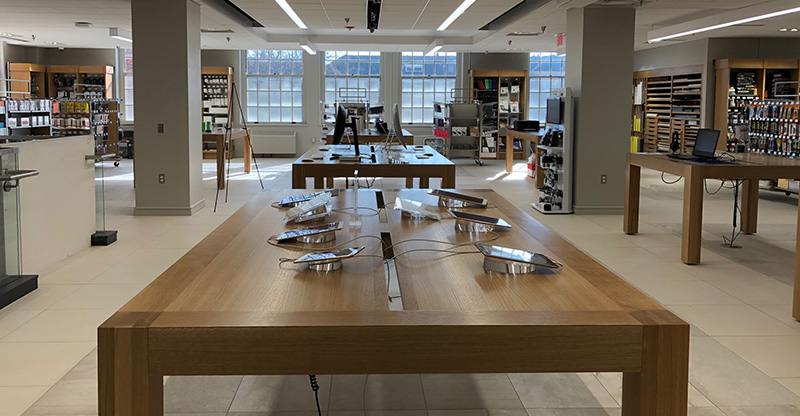Comprehensive Guide to Enterprise IT Service Automation
IT support automation uses software workflows, rule engines, AI/ML, and integrations to automate...
College and university tech bars come in a variety of shapes and sizes. But all are part of a broader “technology support” ecosystem that assures both students and employees of the institution are...

College and university tech bars come in a variety of shapes and sizes. But all are part of a broader “technology support” ecosystem that assures both students and employees of the institution are able to use digital technology reliably.
One common issue for virtually all campus tech bars is balancing staffing with demand. But first you need to answer (as part of that larger technology support ecosystem) four key questions:
Here’s how some other colleges and universities are answering those questions. But ultimately, your best answers will come from (spoiler alert!) collecting your own data.
Whom do you serve? The answers vary widely from one institution of higher education to another. Some colleges and university tech bars only serve students. Others provide help to students, faculty, and staff. At Miami University in Ohio, anyone can visit the MiTech tech bar for free walk-up support, even the community or retirees.
Generally, the student and professional technicians staffing tech bars will do what they can for anyone who walks up. That can mean answering simple technical questions for campus employees, even if the “official” policy is to help students only. But for more complex problems or hardware issues, they may be required to send faculty and staff to a different help desk.
It’s important to note that having an on-campus tech bar often helps instructors, even if they can’t or don’t use those services directly. Tech bars that focus on expanding technology skills and digital literacy for students empower instructors to use more technology in their coursework. knowing the students have a place to go for help—so those teaching the courses don’t have to act as tech support for their students.
Decide: Who are services for?
As with who gets served, the range of services provided varies widely from school to school. Campus tech bars are often designed as technology-focused counterparts to writing centers. They focus on teaching digital literacy and improving technology skills just as writing centers do with grammar, punctuation, and word usage.
But others have more of an IT focus, resolving software and hardware issues simply to keep student technology operational. Others primarily assist with basic needs like WiFi connectivity, campus email, and use of common office software. And still others offer most or all of these services.
What’s common though is for schools to provide some type of resolution path for almost any type of technology-related issue, in order to support student success. That may mean offering a broad range of services at the tech bar. Or it may be directing students and others to an IT help desk for certain hardware and software problems, or even referring them to an off-campus provider for issues like laptop and smartphone repairs.
Decide: What services will be provided?
Where will you direct tech bar visitors for services not provided?
There are two aspects to this. The first is straightforward: what are your tech bar hours of operation? Most campus tech bars start their day between 8:00 and 10:00 a.m., and close up shop between 4:00 and 6:00 p.m. Some offer limited weekend hours as well.
Muhlenberg College in Allentown, Pennsylvania, offers walk-up service only from 2:00-6:00 pm weekdays. At the other end of the spectrum, Boise State University’s Help Desk at The Zone in the Interactive Learning Center operates Monday through Thursday, 7:00am to 10:00pm; Friday, 7:00am-6:00pm; and Saturday and Sunday, 10:00am to 6:00pm.
The second aspect has to do with immediacy, or waiting time. Can visitors get service when it is most convenient for them? Again, policies and practices vary considerably.
Most college and university tech bars offer both scheduled appointments and drop-in service. Appointments may be required or strongly recommended during the busy first few weeks of the semester. But others don’t provide a way to schedule appointments; they offer walk-up service only. If there’s a line, the only options for students are to wait or to stop back at another time.
Decide: When are services available?
Most campus tech bars either don’t collect detailed metrics on activity (number of visitors and types of issues) and user satisfaction, or they adapt software designed for different purposes.
The questions posed above can be best answered, backed by data, if the tech bar has technology in place to track metrics and trends.
Regarding satisfaction, many institutions do collect feedback anecdotally, informally, and / or periodically. Such feedback is generally positive, though not particularly helpful in identifying areas for potential improvement.
The ideal process would be to survey and collect a limited amount of highly relevant, measurable feedback immediately after each visit, while also providing a mechanism for open-ended suggestions.
Every campus tech bar has to answer its own who, what, when, and how questions. Adopting technology can help answer those questions in a way that supports continual improvement.
Kinetic Tech Bar is an end-to-end software solution for managing tech bar operations, from appointment booking to incident tracking and analytics to instant user feedback surveys. Learn more at KineticData.com.

IT support automation uses software workflows, rule engines, AI/ML, and integrations to automate...

Business process reimagined is the strategic renewal of how work gets done by combining modern digital...

You've probably noticed (what we're calling) the "logo-swap test" lately: all the AI ads in market sound...